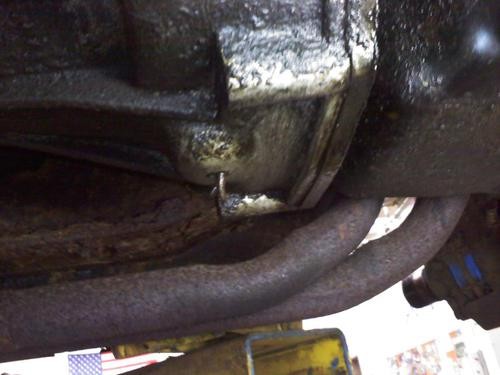The humble cotter pin, often overlooked, plays a crucial role in maintaining the health of your car’s transmission. Specifically, a Transmission Pin, typically found at the bottom of the bell housing, serves a vital purpose. But why is it there, and what does it do? This article will delve into the function of the transmission pin, dispelling myths and clarifying its importance.
 Cotter pin in Transmission (side view).jpg
Cotter pin in Transmission (side view).jpg
The Purpose of a Transmission Drain Hole and its Pin
The transmission, like any other mechanical component, can accumulate debris and moisture over time. To prevent this buildup from causing damage, most transmissions are designed with a drain hole located at the lowest point of the bell housing. This allows for the escape of unwanted contaminants. The transmission pin, inserted into this drain hole, prevents the hole from becoming clogged with dirt, grime, or other road debris.
Why a Cotter Pin? Simple and Effective Design
A cotter pin is a simple, yet highly effective solution for this task. Its split-pin design allows for easy installation and removal, while also providing enough flexibility to withstand vibrations and movement without falling out. The slight movement of the pin, caused by the vibrations of the engine and transmission, further aids in preventing the drain hole from becoming blocked. Additionally, capillary action along the pin can help draw down small amounts of accumulated oil, further preventing buildup within the bell housing.
Dispelling the Myths: It’s Not a Flight Mechanism!
While some might jokingly suggest the transmission pin is a secret launch mechanism or a sacrificial offering to the car gods, its purpose is purely practical. Removing the pin won’t cause your car to fly or explode. However, leaving the drain hole unprotected could lead to a buildup of harmful contaminants within the transmission, potentially leading to costly repairs down the road.
A Legacy of Low-Tech Ingenuity
The use of a cotter pin as a drain hole protector is a testament to the enduring power of simple, effective engineering. This low-tech solution, found in vehicles ranging from vintage Model A Fords to modern MGs, highlights the ingenuity of using readily available components to solve common mechanical problems.
The Transmission Pin: Small Part, Big Impact
In conclusion, the transmission pin is a small but vital component that plays a crucial role in maintaining the health and longevity of your car’s transmission. By preventing the drain hole from becoming clogged, it ensures that harmful contaminants can escape, safeguarding the internal components of your gearbox. So, the next time you’re under your car, take a moment to appreciate the simple brilliance of the transmission pin. It’s a silent guardian, protecting your transmission from unseen threats.
